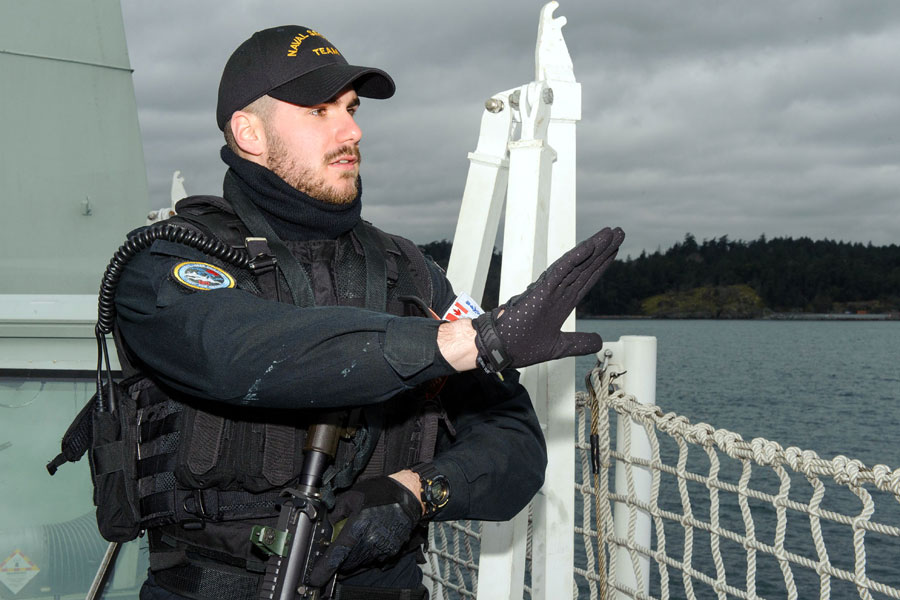Naval Security Team safeguards ships in foreign ports
By Lookout on Apr 17, 2018 with Comments 0

Able Seaman Alex Gauthier, a member of the Naval Security Team, stands sentry watch. Photo by Corporal Blaine Sewell, MARPAC Imaging Services
Darlene Blakeley, Navy Public Affairs Ottawa ~
The safety of ships and sailors in foreign ports is top-of-mind for the flexible, scalable and dynamic team that recently deployed from Maritime Forces Pacific in Esquimalt, B.C., to Copenhagen, Denmark.
For three weeks, the Naval Security Team’s (NST) mission deployment team took over the force protection component of Her Majesty’s Canadian Ship (HMCS) St. John’s’ duty watch during the frigate’s rest and maintenance period in Copenhagen, so that more members of the ship’s company could go home for their designated break during Operation Reassurance.
Op Reassurance is the Canadian Armed Forces’ contribution to NATO assurance and deterrence measures in Central and Eastern Europe. St. John’s began its deployment Jan.18 when it joined Standing NATO Maritime Group One, a naval force made up of ships from various allied countries that work together for a common purpose in the Mediterranean Sea, the North Atlantic Ocean and the Baltic Sea.
The Royal Canadian Navy’s NST provides naval reservists opportunities for real-world, expeditionary operations around the world. The training given to sailors is focused on specific operational and tactical skill sets, and is more advanced than that given during normal trade or occupation training.
“It provides challenging, interesting and unique experiences providing naval effects, both on land and at sea,” says Lieutenant-Commander Jeff Chura, who took over as Commanding Officer of the NST on March 9. “This type of training and work will help re-energize the Naval Reserve by increasing not only recruiting, but also retention.”
For this deployment, the team consists of 36 reservists from 18 Naval Reserve Divisions across the country, representing every military occupation. Together, the team also speaks nine different languages.
LCdr Chura says the training varies depending on the mission type and the size of the group, but the current team conducted four weeks of diverse training including dynamic tactical shooting with the Maritime Tactical Operations Group (MTOG); combat casualty care and first aid; firearms and ammunition training for shoot-no-shoot decision-making development; RCMP training on identifying who is carrying hidden weapons; psychology/mindset of criminal/terrorist suspects; and shipboard force protection organization, duties and responsibilities.
Once this training program was completed, the team underwent a week-long validation period with Sea Training (Pacific) to determine its operational readiness.
“This is something that we as an organization have never had before,” said LCdr Chura. “The training programs are still relatively new and being refined and improved constantly, but I think they have proven so far to provide a well-balanced and effective force.”
In fact, the NST’s first deployment, designed to prove the capability of the concept, was to Busan, South Korea, last year where a team of 78 personnel provided force protection for HMCS Winnipeg during its port visit. Concurrently, the team worked closely with Republic of Korea Navy (ROKN) personnel to develop, practise and execute an exercise demonstration of combined RCN-ROKN operations for both Canadian and Korean flag officers and VIPs.
“Feedback from both Winnipeg and the ROKN was positive,” said LCdr Chura, who has been with the NST team since its inception. “The NST concept was proven beyond a doubt.”
When the Copenhagen mission is over, the NST core team will continue with planning and training for future operations, and the reservists will return to either other Naval Reserve contracts around the country or to their home units. Those with NST training and experience then form a pool of personnel that may be called up to participate in another NST mission deployment team in the future.
“In our current manning construct and operations tempo, there is only one mission deployment team at any one time. But as the team continues to mature and grow there is the possibility that in the future more than one team may be deployed at the same time,” said LCdr Chura. “The NST never rests on its laurels and will always push itself to be better and better.”
Stay connected, follow Lookout Navy News:
Facebook: LookoutNewspaperNavyNews
Twitter: @Lookout_news
Instagram: LookoutNavyNews
Filed Under: Top Stories
About the Author:





